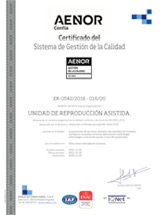A
-
Alopecia
Alopecia
Abnormal hair loss.
-
Amenorrhoea
Amenorrhoea
Absence of menstruation.
-
AMH
AMH
Anti-mullerian hormone. It is measured to determine a woman’s ovarian reserve.
-
Anamnesis
Anamnesis
Information collected by a health professional using a series of questions to ascertain the patient’s state of health.
-
Androgens
Androgens
Male sex hormones.
-
Aneuploidy
Aneuploidy
An alteration in the number of chromosomes.
-
Antiphospholipid syndrome
Antiphospholipid syndrome
An autoimmune disease that makes women more prone to form blood clots and increases the risk of thrombosis, which affects fertility and the risk of miscarriage.
-
Apoptosis
Apoptosis
Programmed cell death. It is a physiological process that all cells in the organism undergo naturally but can sometimes be caused by external agents, such as oxidative stress.
-
Asthenozoospermia
Asthenozoospermia
Decreased sperm motility. Progressive sperm motility must be greater than 32%.
-
Azoospermia
Azoospermia
Absence of spermatozoa in the ejaculate.
B
-
BMI
BMI
Body mass index, which is calculated by dividing weight in kilograms by height in metres squared.
C
-
Corpus luteum
Corpus luteum
The structure that the follicle becomes after ovulation.
D
-
DNA
DNA
Stands for Deoxyribonucleic Acid. It is the material that contains the hereditary information of all living beings.
-
Dysmenorrhoea
Dysmenorrhoea
Pain during menstruation.
E
-
Endometrioma
Endometrioma
A cyst usually formed in the ovary caused by endometriosis.
-
Endometriosis
Endometriosis
An often painful condition in which the endometrium grows outside the uterus.
-
Endometrium
Endometrium
Layer of cells that lines the inside of the uterus, where implantation of the embryo takes place.
-
Epispadias
Epispadias
A malformation of the penis in which the urethra ends in an opening in the upper or dorsal aspect of the penis.
-
Eumenorrhoea
Eumenorrhoea
Normal menstrual function.
F
-
FISH
FISH
Fluorescent In Situ Hybridisation. A genetic laboratory technique for detecting and locating a specific DNA sequence of a chromosome.
-
Follicle
Follicle
Structure containing the egg or oocyte.
-
FSH
FSH
Follicle Stimulating Hormone. Secreted by the pituitary gland. In the female it stimulates follicular development and, in the male, it stimulates sperm production.
H
-
Haemogram
Haemogram
Laboratory test in which the cells contained in the blood are evaluated.
-
Hemi-uterus
Hemi-uterus
Uterus in which only one side of the uterus develops, or uterine hemicavity, which is functional.
-
Hirsutism
Hirsutism
Excessive hair growth in women, in areas where it is not usually present.
-
Hyperprolactinaemia
Hyperprolactinaemia
Higher than normal levels of prolactin.
-
Hypogonadism
Hypogonadism
A disorder in which the ovaries in females and the testes in males produce little or no sex hormone.
-
Hypospadias
Hypospadias
A defect in which the opening of the urethra is not at the tip of the penis.
-
Hypothyroidism
Hypothyroidism
Lower than normal levels of thyroid hormone.
-
Hysterosalpingography
Hysterosalpingography
Radiological test to check the condition of the tubes and uterus.
-
Hysteroscopy
Hysteroscopy
Diagnostic procedure to visualise the inside of the uterus by inserting a lens through the cervix.
I
-
ICSI
ICSI
Intracytoplasmic sperm injection.
-
Infertility
Infertility
A couple’s inability to achieve pregnancy after one year of regular sexual intercourse without contraception.
-
IVF
IVF
In Vitro Fertilisation.
K
-
Karyotype
Karyotype
A laboratory test that examines the size, shape, and number of an individual’s chromosomes.
L
-
Laparoscopy
Laparoscopy
A surgical technique that allows viewing of the pelvic-abdominal cavity by inserting a tube (laparoscope) with a lens through a small incision in the abdomen.
-
LH
LH
Luteinising hormone, secreted by the pituitary gland, responsible for regulating the menstrual cycle and triggering ovulation when the follicle is mature.
-
Luteinisation
Luteinisation
The process of atrophy that the corpus luteum undergoes when the egg is not fertilised.
M
-
MACS
MACS
Magnetic Field Cell Separation. The technique used to separate spermatozoa undergoing apoptosis (programmed cell death) from the rest.
-
Menarche
Menarche
The onset of menstruation.
-
Microfluidics
Microfluidics
Devices that allow the separation of spermatozoa according to certain characteristics such as motility, fragmentation index, etc.
-
MSR
MSR
Stands for Motile Sperm Ratio. Also called sperm capacitation.
-
Myoma
Myoma
Benign tumour in the uterus.
N
-
Necrozoospermia
Necrozoospermia
When the percentage of non-vital spermatozoa in an ejaculate exceeds 58%.
O
-
Oestradiol
Oestradiol
A female sex hormone secreted by the ovary.
-
Oligozoospermia
Oligozoospermia
Less than 15 million spermatozoa per ml in the ejaculate, or less than 39 million in total.
P
-
Pituitary gland
Pituitary gland
An internally secreting gland at the base of the skull that is responsible for the secretion of various hormones, such as LH and FSH.
-
Polycystic ovary
Polycystic ovary
Ovaries in which there are more follicles smaller than 10mm than there usually are in the resting state. This is not the same as polycystic ovary syndrome – an endocrine disorder accompanied by obesity, irregular periods, increased androgens, and hirsutism.
-
Polymenorrhoea
Polymenorrhoea
A disorder with irregular periods, usually with bleeding cycles of less than 21 days.
-
Progesterone
Progesterone
A hormone produced by the ovaries involved in the maintenance of gestation and embryogenesis.
-
Prolactin
Prolactin
Hormone synthesised by the pituitary gland, responsible for the secretion of milk during lactation and the production of progesterone by the corpus luteum.
-
Prolactinoma
Prolactinoma
A benign tumour in the pituitary gland, which causes an increase in prolactin secretion.
S
-
Seminogram
Seminogram
The study of the macro and microscopic characteristics of semen. It is also called spermiogram.
-
Serology
Serology
A test to check for the presence of antibodies in the blood.
-
Sperm capacitation
Sperm capacitation
The process that spermatozoa undergo from the moment they are deposited in the vagina until they reach the egg for fertilisation. In the laboratory, attempts are made to imitate this process by selecting the best motile spermatozoa.
-
Spermiogram
Spermiogram
Laboratory analysis of semen.
T
-
Testosterone
Testosterone
Male sex hormone (although it is also produced in small quantities in women), responsible for the appearance of secondary sexual characteristics in males.
-
Teratozoospermia
Teratozoospermia
When there are less than 4% of morphologically normal spermatozoa in the ejaculate.
-
Tubal pathology
Tubal pathology
Alteration of the functionality of the fallopian tubes.
V
-
Varicocele
Varicocele
Dilatation of the veins that carry blood to the testicle.











